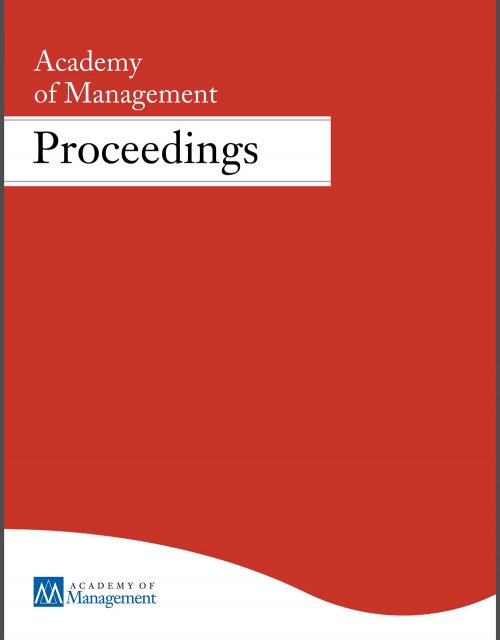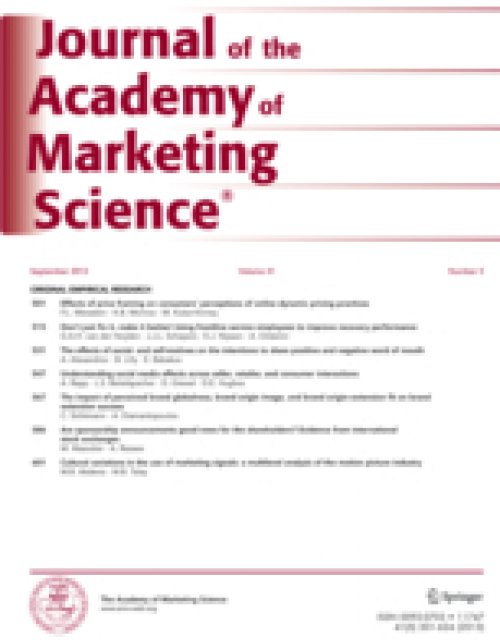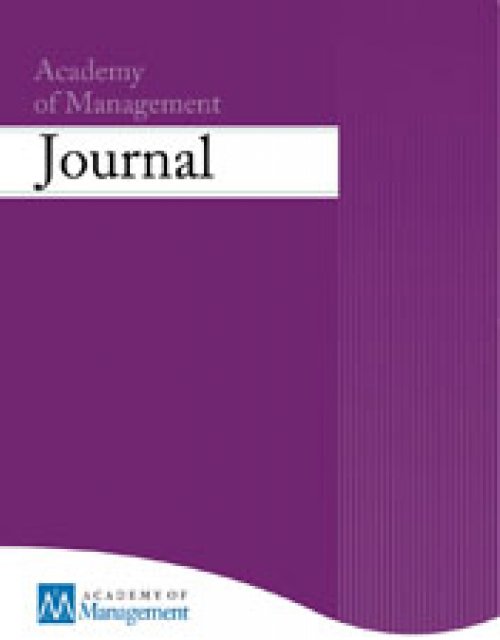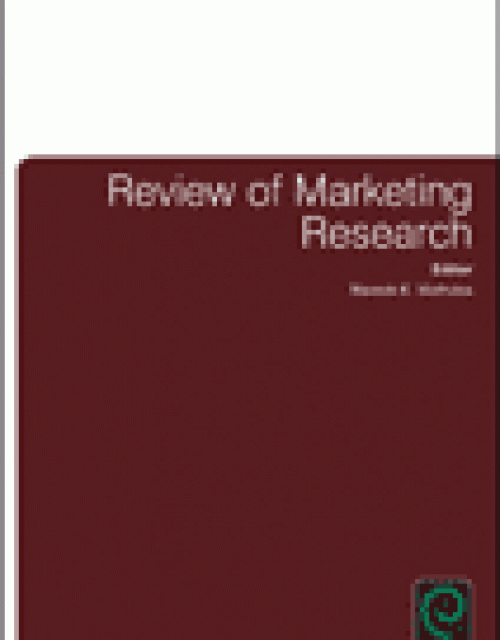Publication records
Subject(s)
Ethics and social responsibility; Marketing
Keyword(s)
business and management, marketing
Secondary Title
Handbook on ethics in marketing
Pages
220–237
ISBN
9781781003428
Subject(s)
Information technology and systems; Technology, R&D management
Winchester House in San Jose, California, was once the residence of Sarah Winchester, the widow of gun magnate William Winchester. This mansion is renowned for its size, its architectural curiosities, and its lack of any master building plan. It is, unfortunately, also a great analogy for how many organizations have constructed their IT systems.
ISSN (Print)
0017-8012
Subject(s)
Technology, R&D management
Keyword(s)
Crowdsourcing, innovation, search
Rejections are common in everyday life, yet their consequences for individual behavior remain little studied. We examine a situation in which organizations invite people outside their boundaries to provide suggestions for formal action. Organizations that receive such suggestions can choose to act upon them, ignore them, or even reject them. While rejections carry a cost (i.e., potentially alienating the suggestion-maker), they are also an important source for motivation and learning. We unite these opposing views and argue that rejections can under certain conditions increase effort; moreover, we document how people learn by changing their behavior when trying again.
With permission of the Academy of Management
Volume
2015
ISSN (Online)
2151-6561
ISSN (Print)
0065-0668
Subject(s)
Marketing
Keyword(s)
Customer inoculation, customer satisfaction, services marketing, service failure
Capitalizing on a large-scale field experimental dataset involving 1,254 airline customers, this study introduces customer inoculation as a new, proactive strategy for mitigating the negative consequences that service failures have on customer satisfaction. Results confirm that customer inoculation eases the decrease in satisfaction when customers experience a service failure. Additional analyses indicate that customer inoculation does not harm customer satisfaction if no service failure occurs. This finding sets inoculation apart from expectation management and underscores the potential inoculation has for marketing practice. Furthermore, contrary to traditional recovery strategies for addressing service failures, customer inoculation operates in advance of a service failure and thereby circumvents potential drawbacks of traditional strategies. In sum, customer inoculation represents a novel strategy for addressing service failures with respect to existing marketing literature and expands the scope of action for companies when they cannot avoid offering occasionally flawed services.
© Academy of Marketing Science 2014 With permission of Springer
Volume
43
Journal Pages
512–527
Subject(s)
Technology, R&D management
Keyword(s)
Selection, evaluation, user-based innovation, crowd sourcing
When organizations reach out to their users for ideas, users take on a considerable role in the innovation process. Including users expands the number of participants and potential ideas from which an organization can select. But how do organizations select some user suggestions while rejecting or ignoring others? We analyze the selection processes at 24,067 organizations that collectively received 702,729 suggestions. Our findings suggest that organizations filter the suggestions they receive by focusing on suggestions that inspire feedback from the user community.
Despite receiving contributions from a diverse pool of users, organizations quickly settle into a pattern of attending to only a few. To our surprise, collective user preferences only matter as a filter mechanism when crowding is high. In contrast, the debate among users about a suggestion strongly increases the likelihood of it being selected by the organization. Our illustration of the screening criteria organizations use to winnow suggestions has broad implications for the selection literature. We also bring insight to the literature on user-driven innovation processes by studying all suggestions that were considered, rather than only those organizations select and implement.
With permission of the Academy of Management
As of May/June 2016, this highly cited paper received enough citations to place it in the top 1% of the academic field of Economics & Business based on a highly cited threshold for the field and publication year. – Data from Essential Science Indicators℠
As of May/June 2016, this highly cited paper received enough citations to place it in the top 1% of the academic field of Economics & Business based on a highly cited threshold for the field and publication year. – Data from Essential Science Indicators℠
Volume
58
Journal Pages
856–880
Subject(s)
Human resources management/organizational behavior
Keyword(s)
status, inequality, small groups, networks, peer effects, organizations
Secondary Title
Emerging trends in the social and behavioral sciences: An interdisciplinary, searchable, and linkable resource
Pages
1–16
ISBN
978-1452216454
Subject(s)
Human resources management/organizational behavior
Keyword(s)
Status, US venture capital industry
This article introduces a distinction between two kinds of status and investigates their effects empirically on the life chances of U.S. venture capital organizations. Using recent research on status-based competition as our starting point, we first describe primary status as a network-related signal of an organization’s quality in a leadership role, and measure primary status as the degree to which a focal organization leads others that are themselves well regarded as lead-organizations in the context of investment syndicates. We then introduce complementary status as an affiliation-based indicator of an organization’s quality in a supporting role, measuring complementary status as the extent to which a focal organization is invited into syndicates by well-regarded lead-organizations—that is, by organizations possessing high levels of primary status. Findings show that both kinds of status negatively affect the rate at which venture capital organizations exit the industry. In addition, consistent with the proposition that primary status and complementary status correspond to distinct market roles and different market identities, primary status and complementary status attenuate each other’s favorable main effects on survival for dedicated venture capital organizations. Theoretically and methodologically oriented scope conditions as well as implications for future research are discussed.
With permission of Elsevier
Volume
52
Journal Pages
588–601
Subject(s)
Ethics and social responsibility; Marketing
Keyword(s)
Attachment, identification, social identity, consumer-brand relationships, brand loyalty
We examine two conceptualizations of consumer-brand relationships: identification, as identity-based relationships between a consumer and a brand, and the related construct of attachment as a bond based on security and personal history with the brand.Predictions emanating from the two constructs’ disparate theoretical traditions regarding the relative antecedents and outcomes of these brand relationship constructs are tested in a survey of real consumer-brand relationships, where the two are likely to co-occur. Identification is more socially motivated, wherein the brand is used for “identity building” and impression management, such as through public endorsement. In contrast, attachment is more personally motivated; it is more likely to be founded on an intimate history with the brand and feelings of security inspired by the brand. This is the first work in marketing to explicitly compare identification with attachment in contexts where they co-occur. In doing so, it underscores the validity and usefulness of these two related but distinct relationship constructs.
With permission of Emerald
Volume
12
Journal Pages
151–174
Subject(s)
Technology, R&D management
Keyword(s)
social networks
Volume
93
Journal Pages
1687–1722



